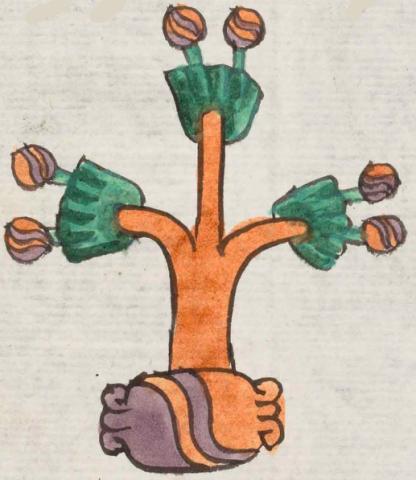Tetzapotitlan (Mdz18r)
This compound glyph for the place name Tetzapotitlan has primarily two features. One is the large stone (tetl) at the bottom, half orange and half purple with parallel wavy lines in the middle and curling (rocky outcroppings) at the ends. The other feature is the tzapotl) tree. The tree is a standard one with a leader and two side branches, and with two-tone green foliage on the branches. What is different, is that the fruit of the tree (two per branch) are shown as stones, also, and with the same coloring of stones. The role of the stone appears to be phonetic; perhaps it could refer to an especially hard tzapotl fruit. The locative suffix (-tlan) is not shown specifically in a visual way (such as with tlantli playing a phonetic role), but the local landscape shown in the compound may serve as a semantic locative.
Stephanie Wood
The fruit being stone is a type of phonetic reinforcement of the tetl visual at the bottom of the glyph.
Stephanie Wood
Stephanie Wood
c. 1541, or by 1553 at the latest
Stephanie Wood
nombres de lugares

-tlan (locative suffix), place, https://nahuatl.wired-humanities.org/content/tlan
Codex Mendoza, folio 18 recto, https://digital.bodleian.ox.ac.uk/objects/2fea788e-2aa2-4f08-b6d9-648c00..., image 46 of 188.
The Bodleian Libraries, University of Oxford, hold the original manuscript, the MS. Arch. Selden. A. 1. This image is published here under the UK Creative Commons, “Attribution-NonCommercial-ShareAlike 3.0 License” (CC-BY-NC-SA 3.0).




